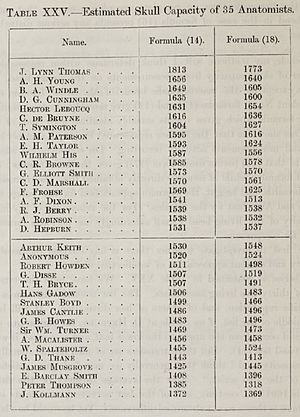Alice Lee (mathematician) facts for kids
Alice Lee (1858–1939) was a British mathematician. She was one of the first women to graduate from the University of London. In 1901, she earned her PhD degree.
Alice Lee worked with a famous scientist named Karl Pearson starting in 1892. She showed that the size of a person's skull (called cranial capacity) did not mean men were smarter than women. This was a big deal at the time!
Contents
Early Life and Learning
Alice Lee studied at Bedford College (London) from 1876 to 1884. In 1879–80, she took the first math class offered there. She was one of the first women to get a degree from the University of London. She earned her science degree (BSc) in 1884 and her arts degree (BA) in 1885.
After graduating, she stayed at Bedford College until 1916. She first worked as a teacher of math and physics. For a few years, she also helped out at the college as a "resident helper." She even helped with Greek and Latin classes later on.
Scientific Work
Around 1895, Alice Lee started attending Karl Pearson's statistics classes. She became very interested in how he used statistics to study evolutionary biology. She decided to work on an advanced degree with him.
Her research looked at how human skull sizes varied. She also studied if skull size was connected to how smart someone was. In 1901, she published her first paper on this topic, called A study of the correlation of the human skull.
She studied three groups of people:
- Women students from Bedford College.
- Male teachers from University College.
- A group of well-known male anatomists (scientists who study the body).
Her study showed that there was no link between skull size and intelligence. She used a special math formula to figure out skull size from measurements.
At that time, many people believed that bigger brains meant more intelligence. They thought that men, who usually had larger heads, were smarter than women. Alice Lee's findings challenged this idea.
Her work caused a lot of debate. Some of the people who reviewed her paper were upset. One of them was an anatomist whose skull size was ranked low in her study! A famous scientist named Francis Galton also questioned her work.
Thanks to Karl Pearson's help, Alice Lee finally received her PhD in 1901. The next year, Pearson published papers that defended her findings. Because no one could truly prove her wrong, her work was soon accepted.
From 1892, Alice Lee worked in Pearson's lab, which focused on biometrics (using statistics in biology). At first, she volunteered. Later, she earned a salary and worked three days a week. Her jobs included:
- Organizing data.
- Calculating numbers that showed how things were related (correlation coefficients).
- Making histogram charts.
- Calculating new types of statistics (chi-squared distribution).
She also did "all the hundred and one things that need doing" and was the lab secretary. Pearson felt she was not paid enough compared to other female workers. She held this paid job until 1907. She continued her teaching at Bedford College until 1916. She often did lab work in her free time or as a volunteer.
While working in the lab, Alice Lee also started her own research. She published four papers by herself. She also helped with 26 other papers but refused to be listed as a co-author. She felt she had only done the math. She was becoming known as a skilled statistician.
For her PhD, she created a math model to estimate the brain size of living people from outside skull measurements. Her research on how much people within a species can vary continued until 1910. She published many papers in a science journal called Biometrika.
Alice Lee's work also helped create tables of functions. These tables were very useful for statisticians and biologists of her time. Her first works on these tables were published in 1896 and 1899. Later works appeared in Biometrika between 1914 and 1927.
First World War
During the First World War, Alice Lee did important statistical work for the government. From 1916 to 1918, she calculated how artillery shells would fly. She also made many tables for the Anti-Aircraft Experimental Section of the Munitions Inventions Department. She even worked on special math projects for the Navy.
Later Life and Legacy
Alice Lee's salary at Bedford College was always lower because she was a woman. Also, the pension plan started too late for her to join. So, when she retired, she didn't have much money to live on.
In 1923, Karl Pearson and Margaret Tuke (the former head of Bedford College) asked the government for help. Pearson highlighted her important research and her "services to scientific work." She was given a special government pension of £70 a year. Alice Lee passed away in 1939 at the age of 81.
Gloria Steinem, a famous writer, has said that Alice Lee's work helped to end the belief in craniology. Craniology was the idea that skull size showed how smart someone was. Although some problems with craniology were noted earlier, Alice Lee's data helped to disprove it in the early 1900s.
The final blow came in 1909. Another scientist, Franklin P. Mall, used statistics to study parts of the human brain. He found no differences between male and female brains.
Images for kids
See also
 In Spanish: Alice Lee para niños
In Spanish: Alice Lee para niños




